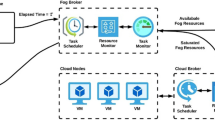Abstract
Due to the large amounts of data required to be processed by the typical Grid job, it is conceivable that the use of optical transport networks in Grid deployment (hence the term “Lambda Grid”) will increase. The exact topology of the interconnecting network is obtained by solving a dimensioning problem, and the outcome of this strongly depends on both the expected workload characteristics and Grid scheduling policy. Solving this combined scheduling and dimensioning problem using straightforward ILP modelling is cumbersome; however, for steady-state Grid operation, Divisible Load Theory (DLT) can yield scalable formulations of this problem.
In this paper, the on-line hierarchical scheduling on a lambda Grid of workload approaching the Grid’s capacity in a two-tier Grid mode of operation is studied. A number of these algorithms are goal-driven, in the sense that target per-resource goals are obtained from the off-line solution to the Divisible Load model. We compare these on-line multiresource scheduling policies for different workloads, Grid interconnection topologies and Grid parameters. We show that these algorithms perform well in the studied scenarios when compared to a fully centralized scheduling algorithm.
Similar content being viewed by others
References
Foster I, Kesselman C (eds) (1999) The grid: blueprint for a new computing infrastructure. Morgan Kaufmann
Foster I, Kesselman C (eds) (2003) The grid: blueprint for a new computing infrastructure, 2nd edn. Morgan Kaufmann
Smarr L, Ford J, Papadopoulos P, Fainman S, DeFanti T, Brown M, Leigh J (2005) The optiputer, quartzite, and starlight projects: a campus to global-scale testbed for optical technologies enabling lambdagrid computing. In: Optical fiber communication conference & exposition and the national fiber optic engineers conference (OFC/NFOEC) 2005, 2005
DeFanti T, de Laat C, Mambretti J, Neggers K, Arnaud BS (2003) Translight: a global-scale lambdagrid for e-science. Commun ACM 46(11):34–41
Hall L, Schulz A, Shmoys D, Wein J (1997) Mathematics of Operations Research. Scheduling to minimize average completion time: off-line and on-line approximation algorithms. Math Oper Res 22(3)
Feitelson D, Rudolph L, Schwiegelshohn U, Sevcik K, Wong P (1997) Theory and practice in parallel job scheduling. Springer
Sgall J (1998) On-line scheduling—a survey. Lecture notes in computer science, vol 1442
Kolish R, Padman R (2001) An integrated survey of project scheduling. OMEGA Int J Manag Sci 29(3)
Ranganathan K, Foster I (2003) Simulation studies of computation and data scheduling algorithms for data grids. J Grid Comput 1(1)
Cameron D, Carvajal-Schiaffino R, Millar A, Nicholson C, Stockinger K, Zini F (2003) Evaluating scheduling and replica optimisation strategies in optorsim. In: 4th International workshop on grid computing (Grid2003), 2003
Ernemann C, Hamscher V, Streit A, Yahyapour R (2002) Enhanced algorithms for multi-site scheduling. In: 3rd International workshop on grid computing (Grid2002), 2002
Bucur A, Epema D (2002) An evaluation of processor co-allocation for different system configurations and job structures. In: 14th IEEE symposium on computer architecture and high performance computing, 2002
Bucur A, Epema D (2000) The influence of the structure and sizes of jobs on the performance of co-allocation. In: 6th Workshop on job scheduling strategies for parallel processing, 2000
Buyya R, Murshed M, Abramson D (2002) A deadline and budget constrained cost-time optimization algorithm for scheduling task farming applications on global grids. In: The 2002 International conference on parallel and distributed processing techniques and applications (PDPTA’02), 2002
Thysebaert P, Volckaert B, Turck FD, Dhoedt B, Demeester P (2004) Network aspects of grid scheduling algorithms. In: 17th International conference on parallel and distributed computing systems (PDCS’04), 2004
Hung J, Kim H, Robertazzi T (2002) Scalable scheduling in parallel processors. In: 36th Annual conference on information sciences and systems (CISS’02), 2002
Yu D, Robertazzi, T (2003) Divisible load scheduling for grid computing. In: 16th International conference on parallel and distributed computing systems (PDCS’03), 2003
Marchal L, Yang Y, Casanova H, Robert Y (2005) A realistic network/application model for scheduling divisible loads on large-scale platforms. In: 19th IEEE international parallel and distributed processing symposium (IPDPS’05), 2005
Keren A, Barak A (2003) Opportunity cost algorithms for reduction of i/o and interprocess communication overhead in a computing cluster. IEEE Trans Parallel Distrib Syst 14(1):39–50
Farooq U, Majumdar S, Parsons E (2005) Dynamic scheduling of lightpaths in lambda grids. In: IEEE/create-net international workshop on networks for grid applications (GRIDNETS 2005), 2005
Zhu Y (2003) A survey on grid scheduling systems, Ph.D. Qualifying exam. Hong Kong University of Science and Technology
Thysebaert P, Leenheer MD, Volckaert B, Turck FD, Dhoedt B, Demeester P (2006) Scalable dimensioning of optical transport networks for grid excess load handling. Photon Netw Commun 12(2):117–132
Author information
Authors and Affiliations
Corresponding author
Rights and permissions
About this article
Cite this article
Thysebaert, P., Volckaert, B., De Leenheer, M. et al. Dimensioning and on-line scheduling in Lambda Grids using divisible load concepts. J Supercomput 42, 59–82 (2007). https://doi.org/10.1007/s11227-006-0036-x
Published:
Issue Date:
DOI: https://doi.org/10.1007/s11227-006-0036-x




